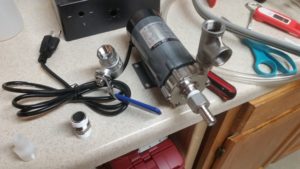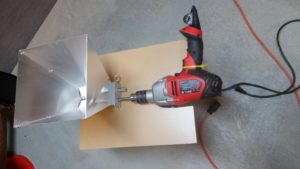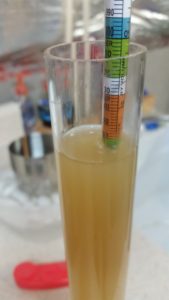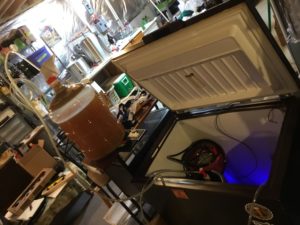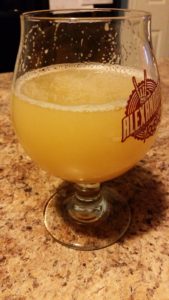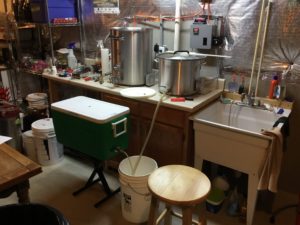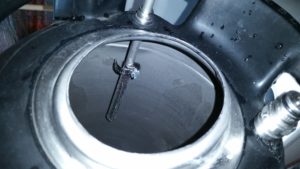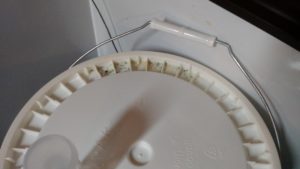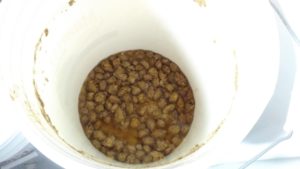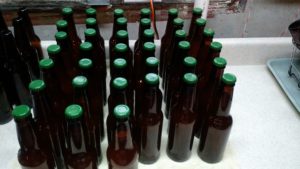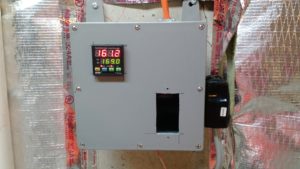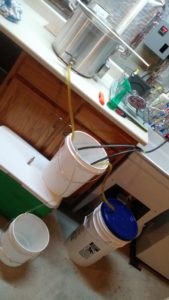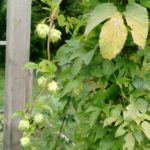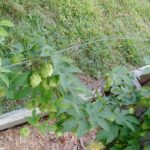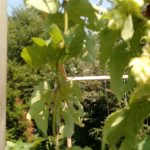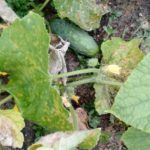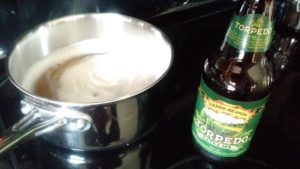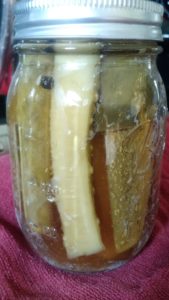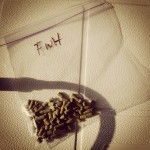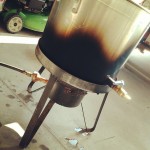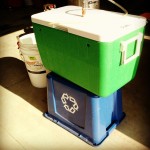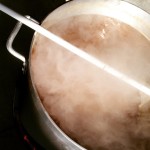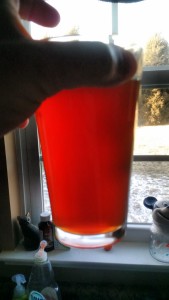Tag Archive: IPA
Mango Vanilla Milkshake IPA Brew Day
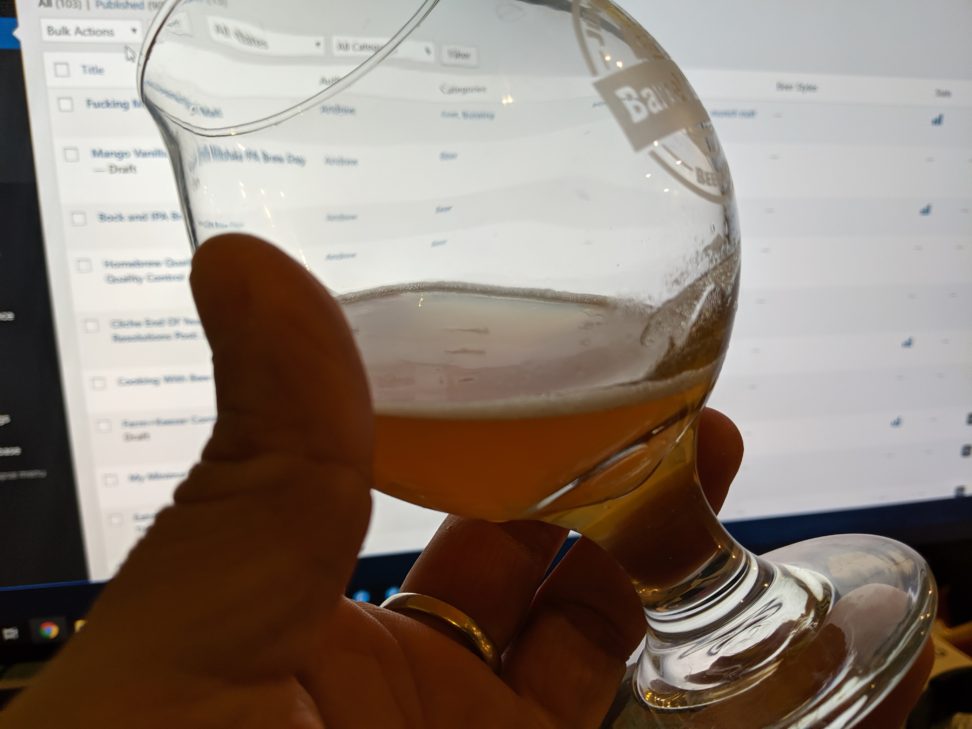
Sometimes you’re Two Hearted. Sometimes you’re Natty Light. This brew day felt more like Natty Light.
I was not actually ready to brew. I had most of the ingredients. I had the yeast I wanted to use. I had most of the hops I wanted to use. I had the mango. I had both vanilla beans and a vanilla tincture. I didn’t have water put out, but I had Campden Tablets… which I had to look for.
I also am trying to make small improvements in my brew day. I’ve been adding tri-clover fittings to everything… the decision to use this type is due to my boil kettle having that type – and I want only one system.

In addition to the tri-clover fittings, I had a three-way valve. Something I’ve never used.
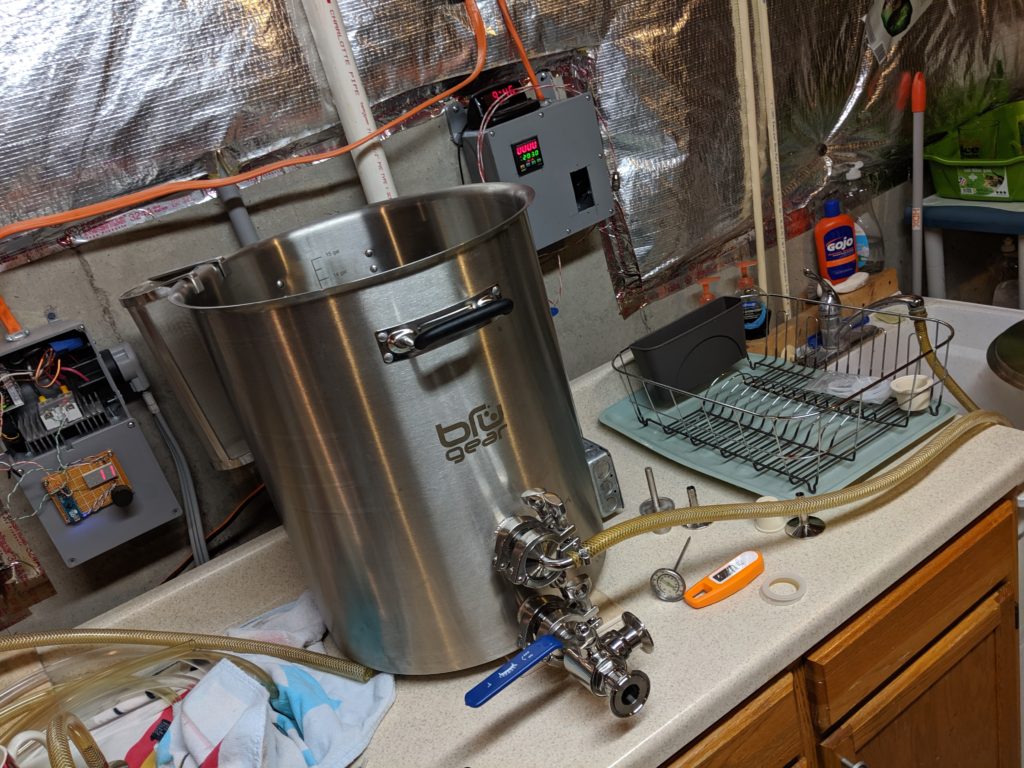
So I start getting the HLT heated up (and it’s temperatures are not reading correctly, as I found in my last brew day), and getting some water started to pre-heat my mash tun. At that point, I decided to mill my grain. My system for this is really shoddy – I have my mill mounted to a too-thin piece of plywood with nothing to ensure that all the milled grains go into a bucket. Usually, I can get all the grist into the bucket. This time was different, I lost a fair bit to the floor.
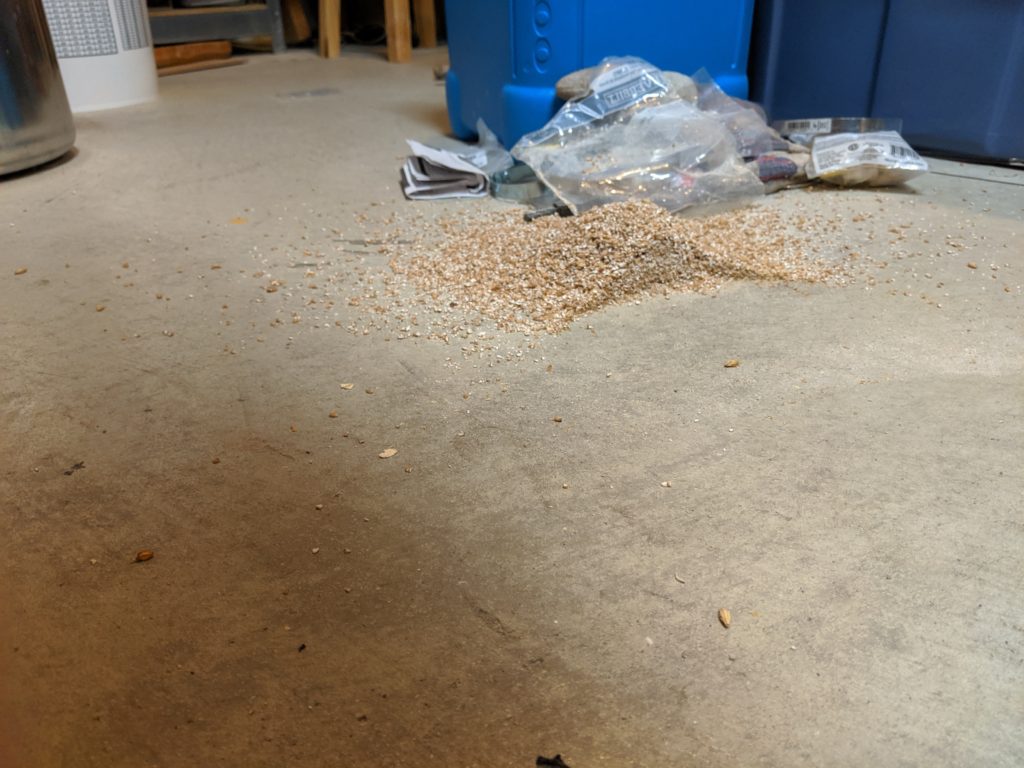
I mashed in and hit my temps and somewhat close to my gravity numbers… given that I had a bit of malt sitting on the ground that went into the trash can.
Then I got to 15 minutes remaining in the boil. I added a late charge of hops and started setting up for a whirlpool and to run hot wort through my new counterflow chiller… and I was one tri-clover clamp short. I tried to adapt by attaching my pump directly to that new three-way valve. As soon as I powered up the pump, it started squealing so I turned it back off. After much finagling, I got the pump running on the “wrong” side of the chiller. I would have preferred to have the pump between the kettle and the chiller… I was able to get stuff running by having the pump between the chiller and the whirlpool inlet. I then added the whirlpool hops and (oops, late) lactose.
I had a very weak whirlpool that made me concerned, but I let it go… and it did chill. I got the wort down to around 85 and had difficulty getting the three-way valve to send the wort to the fermenter. After finally getting it there, I pitched some Omega Hothead Kveik.
After two weeks in the fermenter, I added mango. I used 5 pounds of frozen cubes that I slightly thawed in my microwave and then pureed in the blender (sanitized, of course) and dumped the puree in via a funnel. A few days later, after the secondary fermentation kicked off, I added around 8 ounces of vanilla bean tincture (cheap vodka aging 4 vanilla beans that were sliced open). I had so much difficulty with getting samples that I cold-crashed the fermenter and kegged without too much tasting. I was half a gallon low into the fermenter (I target 5.5 gallons in the fermenter any time I dry hop). I lost a gallon to fruit. Maybe it would have been better if I cold crashed longer, but I’m not sure.
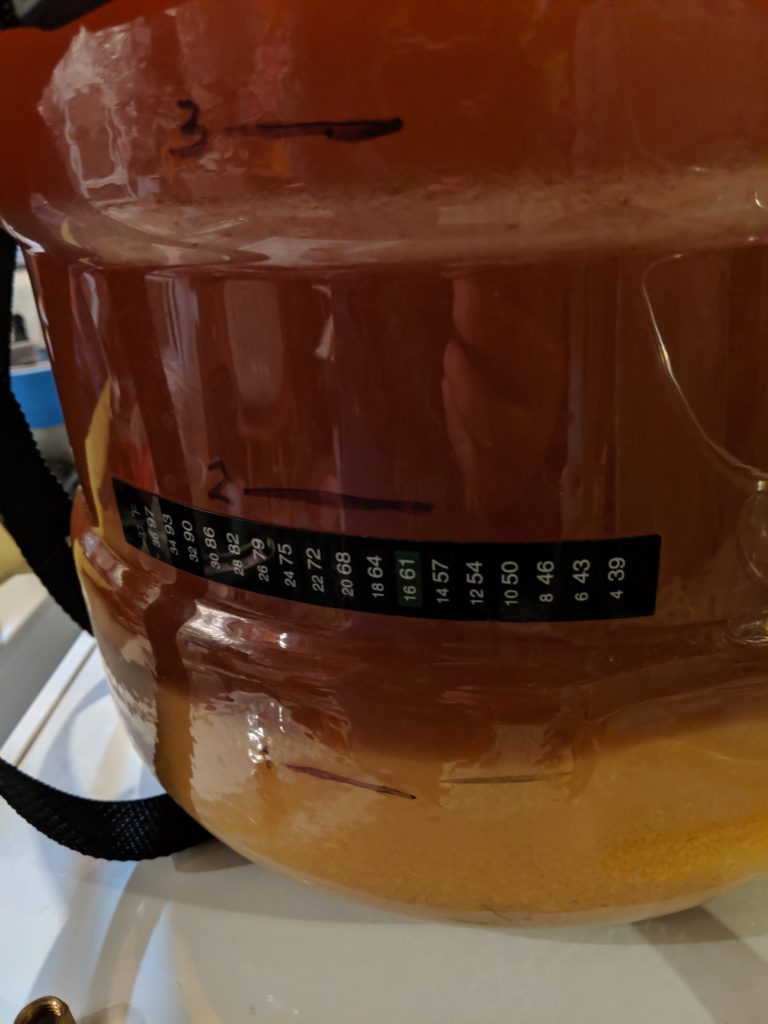
I kegged it on July 7 with some keg hops. I was hoping that I could take it to a homebrew club meeting on July 11. Between running out of CO2 and green hop flavor, it wasn’t happening.
The aroma is vanilla and tropical fruit, obviously dominated by mango. The appearance is opaque copper. Once properly carbonated and aged to allow the hops to meld a little, the flavor is quite nice – the slight carbonic acid bite actually works well here. There’s a lot of hop flavor, little bitterness (but there is some), and some vanilla that comes in late. There is a sweetness to it, which is as expected. The mouthfeel has a slight thickness, which works well for the style but could probably use to be amplified.
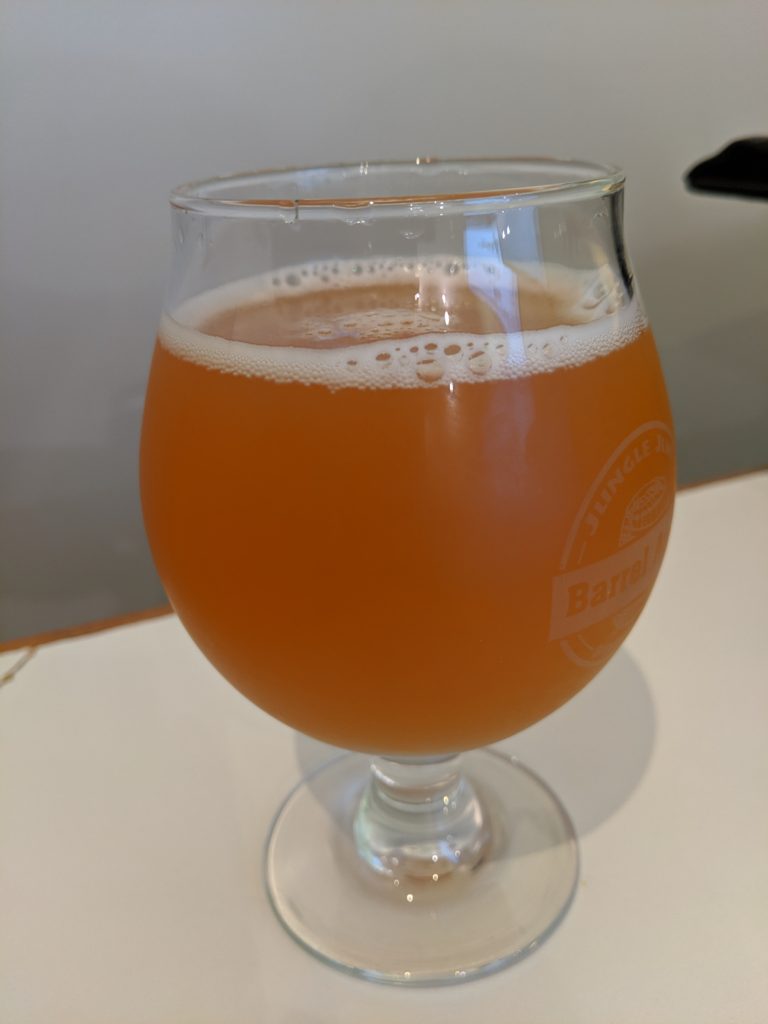
Cheers!
White IPA Brew Day
One of the beers that I’ve purchases as a 6-pack that didn’t stay in my fridge very long was MadTree’s Luna Lux (link includes recipe). For whatever reason, it became my go-to beer for all of six evenings, and that was after having (and thoroughly enjoying) a pint at a local pizza place.
So what does a homebrewer do when a place like MadTree gives you (and everyone!) the recipe? I think most homebrewers would spin it a little. Which I did…
Recipe Details
| Batch Size | Boil Time | IBU | SRM | Est. OG | Est. FG | ABV |
|---|---|---|---|---|---|---|
| 5.5 gal | 60 min | 70.6 IBUs | 6.3 SRM | 1.053 | 1.013 | 5.3 % |
| Actuals | 1.046 | 1.01 | 4.7 % | |||
Style Details
| Name | Cat. | OG Range | FG Range | IBU | SRM | Carb | ABV |
|---|---|---|---|---|---|---|---|
| white ipa | 21 B | 1.056 - 1.065 | 1.01 - 1.016 | 40 - 70 | 5 - 8 | 2.4 - 3 | 5.5 - 7 % |
Fermentables
| Name | Amount | % |
|---|---|---|
| White Wheat Malt | 1.5 lbs | 13.64 |
| Caramel Malt - 20L (Briess) | 8 oz | 4.55 |
| Pale Ale Malt 2-Row (Briess) | 9 lbs | 81.82 |
Hops
| Name | Amount | Time | Use | Form | Alpha % |
|---|---|---|---|---|---|
| Warrior | 0.12 oz | 60 min | Boil | Pellet | 15 |
| Jarrylo | 1 oz | 20 min | Boil | Pellet | 16 |
| Galaxy | 1 oz | 20 min | Aroma | Pellet | 14 |
| Citra | 1 oz | 20 min | Aroma | Pellet | 12 |
| Citra | 1 oz | 7 days | Dry Hop | Pellet | 12 |
| Galaxy | 1 oz | 7 days | Dry Hop | Pellet | 14 |
| Jarrylo | 1 oz | 7 days | Dry Hop | Pellet | 16 |
Miscs
| Name | Amount | Time | Use | Type |
|---|---|---|---|---|
| Lemon Peel | 1.20 oz | 0 min | Boil | Spice |
| Coriander Seed | 0.50 oz | 0 min | Boil | Spice |
Yeast
| Name | Lab | Attenuation | Temperature |
|---|---|---|---|
| Belgian Witbier (3944) | Wyeast Labs | 74% | 62°F - 75°F |
Mash
| Step | Temperature | Time |
|---|---|---|
| Mash In | 152°F | 60 min |
Download
| Download this recipe's BeerXML file |
Brew day was normal with only a few complaints of things I really need to fix – specifically I need to add releases that aren’t hose-barb connectors. And I still hate my plate chiller. This was the first brew day with my new pump, which worked splendidly, although there’s a few details I need to deal with (specifically, I need to have an outlet that I don’t block with kettles, I need to redo one of the fittings, and I need to mount this to a piece of wood or something as a base).
The grain milling needs some fixes, but they’re small. For starters, I need a thicker piece of wood to attach the drill to, and it needs to hold in place with the bucket. And I need to make sure the drill is spinning in the correct direction! Ultimately, I want to move milling outside because of the dust and the fact that I lost a few kernels to the floor.
This fermented for three weeks at 64F, which is the lowest end of the recommendations from Wyeast.
Packaging
I closed transfered from the fermenter to the keg.I’ve tried to do this once before, but this time worked better and with a few small modifications, this will work well.
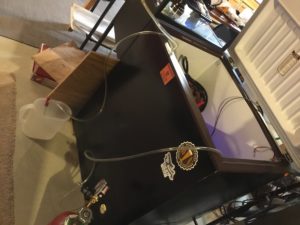
The destination keg is in the keezer, the line coming out and into the pitcher is from the gas in post on the keg.
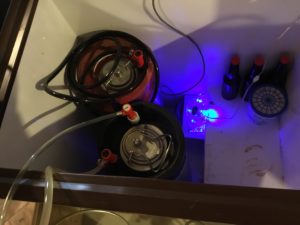
That’s what it looks like in the keezer… And yes, I have a lighted computer case fan circulating air in there.
Log
2018-02-25: Brewed
2018-03-04: 1.016 @ 67F
2018-03-07: 1.010 @ 67F
2018-03-13: 1.008 @ 67F
2018-03-16: 1.008 @ 67F
2018-03-18: Kegged
Tasting Notes
Appearance:hazy pale yellow with a thin lasting white head. Plenty of lacing on the glass.
Aroma: fruity hops with lemon undertone. No esters or phenols.
Flavor: light crackery malt with some orange and lemon flavor. Some spice in the background. Lasting light bitterness, but not overwhelming. No yeast character.
Mouthfeel: light-bodied. Dry and only slightly prickly from the carbonation.
Overall: I’m really enjoying this beer. The flavors really came together. I would have liked a lot more yeast character and a little more hop flavor and aroma, though. I think the next version may have a little bit more dry hopping and will be fermented warmer.
Awards: Won silver in the Hammerdown Brewcup 2018!
Cheers!
IPA Brew Day – Make IPA Great Again!
It was a dark and stormy brew day.
No, actually, it was cold and cloudy. I was inside though. I started the brew day at 7:30 AM by getting both kettles going with water – the BK had the mash tun heat up water and the HLT had my strike water (which I measured the prior night and filled the HLT to let the chlorine dissipate. I put a lid on the BK and then went upstairs to make breakfast for the family.
Backstory
I decided that since I now have two medals in styles that I like (but not love), I am going to try to medal in styles that I love – which basically means IPA. Maybe APA. Probably also British Bitter. Possibly dunkelweisen too (we’ll see). This is the first of that – I want to make an IPA that hits all the marks in the right spot. While I have been really enjoying some NEIPAs (specifically those from Listermann Brewing), this one will be clear, bitter, and aromatic. I want only some malt sweetness, and I definitely want it to take a backseat to the hops.
Brew Day
Upon returning to the basement brewery, I pulled the lid giving myself a nice steam burn on my left arm. I realized the element was at the max despite being set to ‘5’. I think the SSR is melted. I pulled the plug on the BK and drained the water into the mash tun to preheat while I added 5 ml of acid to the HLT for the mash water. Once the mash tun was mostly empty, I dumped the rest and dumped the grain into it. I shut the element off on the HLT and doughed in, hitting a mash temp of 154ºF, which only dropped to 152ºF over the hour rest. Mash pH was good, at about 5.3. After the hour, I recirculated and lautered for more sweet wort than I’ve ever received for first runnings – it was around 3.1 gallons, I was shooting for 3.5 gallons. Looks like the union I installed into the mash tun helped! I began the batch sparge and 10 minute rest and then dumped the first runnings into the BK. After the rest, I recirculated and lautered for just under 3.5 gallons for the second runnings and added the second runnings to the first in the boil kettle. I stirred and pulled a sample and then began boil.
And what a boil it was. Since the SSR was melted, it’s like using a propane burner on max. I started with around 6.5 gallons, and my final volume was around 5 before chilling caused me to lose some more (maybe 0.5 gallons, I ended up with 4.5 in the fermenter). When adding my 15 minute hop addition, I rigged the plate chiller and started recirculating boiling wort through it without running anything in the cold side. 15 minutes later, I shut off the element and turned on the cold water to begin chilling. At some point my pump failed, as it wasn’t pumping anything. My response to this was to use gravity to chill to my bottling bucket, and then drain the bottling bucket through the plate chiller and into the fermenter. This worked (I got down to 72ºF or so), but it was a pain and subjected the wort to some oxygen when it is most vulnerable to oxidization.
I pitched the yeast, I decided to use Denny’s Favorite, which appears to be from North Coast Brewing (the people that make Old Rasputin). The Fermentation temperature reached 75ºF around 24 hours post-pitch, and around 40 hours post-pitch was down to 70-72ºF.
Recipe
.
[beerxml recipe=”http://www.runningonbeer.net/wordpress/wp-content/uploads/2017/11/MakeIpaGreatAgain.xml” metric=false mhop=false misc=true]
Serving
After conversing with some fellow homebrewers on Reddit, I decided to give this a week to 10 days in the fermenter, crash it, rack it to a keg with an added hop sock of the dry hops and slow carbonate it over a week or so.
Notes
2017-11-11: Brewed
2017-11-19: Kegged
https://twitter.com/HamBrew807/status/933109708378034177
Cheers!
IPA Bottled… God, I Hate Bottling. And Mold.
I had this IPA sitting in the fermenter a week longer than I anticipated. It had to be bottled this week, though – next week is likely going to be busy (I’m volunteering with the Cincinnati Queen Bee Half Marathon for part of Saturday, and Sunday will likely be busy with family). This is a somewhat fitting end to a great weekend… well, the lovely citrus hop aromas was a fitting end, the rest, not so much.
Friday kicked off with Pint Night courtesy of my wife asking for Woodchuck Harvest Cider. The featured brewery was 5 Rabbit Cerveceria, and in attendance was Randy Mosher (partner and creative director at 5 Rabbit). I got to talk to Randy for a few minutes, which was awesome since I’ve read two of his books. I found out he went to the University of Cincinnati College of Design, Architecture, Art, and Planning (DAAP) “when it was just DAA, before the P”. I told him I went there for urban planning, in DAAP, after they added the P. It was a true beer geek moment, and I was savoring it with their Yodo con Leche, which is among the best beers I’ve tasted!
Saturday, my wife arranged for her parents to babysit the kids and we went to Rivertown Brewery and Barrelhouse. We arrived just behind a bus full of beer geeks. Initially I was concerned that getting a flight and a seat would be an issue, but fortunately neither was an issue, and we ended up having a nice conversation with a couple that were on the bus.
Sunday began with a little bit of NFL from London and me beginning bottling.
Things were a little more difficult this time because of mold. Part of me wants to blame HBF or AHA or something because one of them tweeted out something about it, but it’s really not their fault. And all this was on the outside. To add to the mold problem, I didn’t have enough corn sugar, so I decided to use math and use a partial batch of corn sugar and sucrose.
Once I boiled the sugar solution (upstairs in the kitchen) and moved it downstairs (to the brewery), I decided to wash all the bottles I was going to use. Normally I don’t because I wash all bottles before taking them into the basement, I decided a change was in order because one of my cats has taken up residence in the basement. I really don’t want cathair in my IPA. Then I had to sanitize the bottles. I don’t own a bottle tree, so dealing with bottles is a painful process of draining bottles on a dish drainer and then setting them on a towel.
I believe I was able to open the fermenter without getting any mold into the beer. This was an AWESOME smelling beer! As soon as I opened the fermenter I was greeted with citrus aromas from the citra, galaxy, and cascade hops I used. Bottling was without incident, and I now have 39 bottles of green capped goodness conditioning in my basement.
The stats:
78 IBU, 6.3%ABV, OG 1.056, FG 1.008.
Of course, this was not the end of bottling day. The mold was not only on my fermenter lid, but also in the freezer. I had to spend some time cleaning it out with antibacterial cleaner. I decided to remove the thermocouple and go with another solution. I also decided that making lagers wasn’t as important to me as not bottling anymore, and I decided I’m going to move towards kegging. I spent a large part of the afternoon on Facebook messenger pelleting a friend of mine with questions.
Cheers until next week!
Another IPA Brew Day
So I decided later than usual on a Saturday to brew. This is a brew that I wanted to do the prior weekend, but my home AC was on the fritz and adding a bunch of humidity to it would not have been a very smart move.
This was an interesting brew day for two reasons. A large portion of the brew day was spent thinking that I would be preparing to brew the following day. I built an electric panel to fix the dangerous setup I had previously.
The thing is, I didn’t have the plug on the cord from the boiler ready. Once I did that, I added water and started things up. Then I went to work on preparing the mash tun. In my last post, I had the stuck sparge from Hell. I did NOT want that happening again. I added some plumbing solder in some strategic places and scrubbed down the copper. At that point (and after messing up and fixing solder joints twice, and since leaks don’t really matter here the mess ups were pretty important to fix), I decided to go ‘all in’ and start mashing.
I love problems that fix themselves!
This brew day had one minor mess up – for my IPA, I have hops at first wort (in the kettle), 15, 5, knockout, and dry. I did first wort, 15, 10, and knockout. Oops. It also had one issue that I thought would be a huge problem – my sparge water kept heating even after the PID said things were off. I didn’t notice until the water hit 205º F, and the heat was still on despite the output light on the PID controller not being on. So I unplugged the boiler to keep the water from boiling and let it cool. Later, when it was time to heat the water back up to sparge temperatures, I plugged the boiler back in and let it heat back up. And it worked correctly. And it worked correctly through the entire boil, too. I love problems that fix themselves!
They leak
Chilling had been an issue in the past, and I still reign supreme at having the most fucked up chilling schemes. This one isn’t much different. I bought a plate chiller on Amazon a few weeks ago. The water inlets and outlets were standard hose fittings. My house is six years old, and the cheap washing machine lines were something that was on the list of things to replace. I decided to purchase new stainless steel lines for the washing machine and use the old lines for the plate chiller.
They leak. Somehow in the process of unhooking them from the back of the washing machine and the wall and putting them on the plate chiller, they decided to leak. And these weren’t leaks that could be fixed by torquing down the connectors or using pipe tape (which is unnecessary on these connectors). And I made sure the O-rings were in the hose connectors.
So I did what any sane person would do. Since I didn’t have enough hose to set the plate chiller in the sink (that would have been optimal), I put the chiller in a bucket. Which started to fill. So to avoid flooding part of my basement, I used a small hose to siphon the leaking water out of the main bucket into another so I could dump water without moving the plate chiller around.
So on the shopping list is two new hoses. Because had I had not-leaking hoses, the plate chiller would have worked very well. And even allowing a lot of the trub go through was okay (I use pellet hops). I’m not sure what temperature I got things down to. Put the ale pail into the fermentation chamber and set it to chill at about 6:30. I ended up pitching the yeast at midnight or so.
The Recipe
The recipe has changed a little. I wanted it a little less malty and a little more crisp.
Recipe Details
| Batch Size | Boil Time | IBU | SRM | Est. OG | Est. FG | ABV |
|---|---|---|---|---|---|---|
| 5 gal | 60 min | 71.4 IBUs | 5.4 SRM | 1.070 | 1.013 | 7.6 % |
| Actuals | 1.051 | 1.01 | 5.4 % | |||
Style Details
| Name | Cat. | OG Range | FG Range | IBU | SRM | Carb | ABV |
|---|---|---|---|---|---|---|---|
| American IPA | 14 B | 1.056 - 1.075 | 1.01 - 1.018 | 40 - 70 | 6 - 15 | 2.2 - 2.7 | 5.5 - 7.5 % |
Fermentables
| Name | Amount | % |
|---|---|---|
| Pale Malt (2 Row) US | 7 lbs | 50 |
| Vienna Malt | 6 lbs | 42.86 |
| Cara-Pils/Dextrine | 1 lbs | 7.14 |
Hops
| Name | Amount | Time | Use | Form | Alpha % |
|---|---|---|---|---|---|
| Cascade | 2 oz | 15 min | First Wort | Pellet | 6.6 |
| Cascade | 0.5 oz | 15 min | Boil | Pellet | 6.6 |
| Citra | 0.5 oz | 15 min | Boil | Pellet | 12 |
| Galaxy | 0.5 oz | 15 min | Boil | Pellet | 11 |
| Cascade | 0.5 oz | 5 min | Boil | Pellet | 6.6 |
| Citra | 0.5 oz | 5 min | Boil | Pellet | 12 |
| Galaxy | 0.5 oz | 5 min | Boil | Pellet | 11 |
| Cascade | 1 oz | 15 min | Aroma | Pellet | 6.6 |
| Citra | 1 oz | 15 min | Aroma | Pellet | 12 |
| Galaxy | 1 oz | 15 min | Aroma | Pellet | 11 |
| Cascade | 1 oz | 7 days | Dry Hop | Pellet | 6.6 |
| Citra | 1 oz | 7 days | Dry Hop | Pellet | 11 |
| Galaxy | 1 oz | 7 days | Dry Hop | Pellet | 11 |
Miscs
| Name | Amount | Time | Use | Type |
|---|---|---|---|---|
| Irish Moss | 0.25 tsp | 15 min | Boil | Fining |
Yeast
| Name | Lab | Attenuation | Temperature |
|---|---|---|---|
| American Ale (1056) | Wyeast Labs | 75% | 60°F - 72°F |
Mash
| Step | Temperature | Time |
|---|---|---|
| Mash In | 148°F | 60 min |
Now the wait. One week (as of time of writing) to add dry hops, and one week to absorb. Then bottling and another week to two weeks to wait. I WISH IT WAS DONE ALREADY.
Cheers!
Hopped Pickles
The garden has come along swimmingly.
- Hops
- Hops
- And more hops!
- Oh look, a cucumber!
So I had two cucumbers ready (maybe, they may have been a little under-ripe) and some hops. Roughly 0.1 oz of Columbus (wet) and more Tettenang and Cascade.
The original reason for growing cucumber was hopped pickles, which my wife first heard about on The Chew TV show. In looking it up, a good sounding recipe is here (yeah, she has blue-green hair, but she also has great taste in beer!).
I cut the recipe to 1/4 of the amounts. I didn’t have any pickling salt, so I used sea salt (per another internet search) and I used a few sprinkles of ground mustard instead of mustard seed (and added both to the list of things to buy at the grocery store next week). I used 0.1 oz of wet Columbus and 0.25 oz of wet Tettenang. I used a Sierra Nevada Torpedo Extra IPA, which has a nice hoppy flavor that should go well with the recipe and add enough bitterness to be similar enough to Hopslam, as Ms. Porter used or Dogfish 90 minute IPA, which is what you can purchase commercially. Hopslam is 70 IBU, and 90 Minute IPA is 90, Torpedo clocks in at 67 IBU. In all three cases, there is quite a bit of hop aroma from late hops/hopstands/dry hop additions.
In the jar, I threw a cascade cone into the jar with the smashed garlic clove, 1/4 oz of peppercorn, half a fresh de-seeded and de-veined jalapeno. Everything else was to the directions (1/2″ headspace, 15 minute process in boiling water).
So this was done on August 29. The recipe says “a few days” for flavor, but I’m thinking I want to give these two weeks, which is consistent to other pickled recipes I’ve used.
Cheers!
EDIT: I tried these after a few weeks. The strongest flavor is garlic, but the hops are in there and they are GOOD! I may try another batch with no garlic and see what happens.
Friend of Hades IPA Recipe
So I’m starting to experiment with different malts. I started looking into various SMaSH recipes and started seeing people use different base malts. So I decided to base this one on Vienna malt instead of the normal 2-row malt. I also added some carared for color, some carapils for head retention, and crystal 40 for a touch of sweetness and color. I also kicked up the hops quite a bit since my last (extract+partial mash) IPA. The last (also first) IPA I brewed had 7oz of hops (3 oz of Cascade, 2 oz of Citra and Galaxy). This time, I added an extra 3 oz of hops. I also experimented with first wort hopping and steeping (the closest I can get to hopstanding right now).
Here is the recipe.
Recipe Details
| Batch Size | Boil Time | IBU | SRM | Est. OG | Est. FG | ABV |
|---|---|---|---|---|---|---|
| 5 gal | 60 min | 67.7 IBUs | 11.5 SRM | 1.066 | 1.015 | 6.7 % |
| Actuals | 1.051 | 1.01 | 5.4 % | |||
Style Details
| Name | Cat. | OG Range | FG Range | IBU | SRM | Carb | ABV |
|---|---|---|---|---|---|---|---|
| American IPA | 14 B | 1.056 - 1.075 | 1.01 - 1.018 | 40 - 70 | 6 - 15 | 2.2 - 2.7 | 5.5 - 7.5 % |
Fermentables
| Name | Amount | % |
|---|---|---|
| Vienna Malt | 9 lbs | 69.23 |
| Carared | 2 lbs | 15.38 |
| Cara-Pils/Dextrine | 1 lbs | 7.69 |
| Caramel/Crystal Malt - 40L | 1 lbs | 7.69 |
Hops
| Name | Amount | Time | Use | Form | Alpha % |
|---|---|---|---|---|---|
| Cascade | 0.5 oz | 15 min | First Wort | Pellet | 6.6 |
| Cascade | 0.5 oz | 60 min | Boil | Pellet | 6.6 |
| Cascade | 0.5 oz | 15 min | Boil | Pellet | 6.6 |
| Citra | 0.5 oz | 15 min | Boil | Pellet | 12 |
| Galaxy | 0.5 oz | 15 min | Boil | Pellet | 11 |
| Cascade | 0.5 oz | 5 min | Boil | Pellet | 6.6 |
| Citra | 0.5 oz | 5 min | Boil | Pellet | 12 |
| Galaxy | 0.5 oz | 5 min | Boil | Pellet | 11 |
| Cascade | 1 oz | 15 min | Aroma | Pellet | 6.6 |
| Citra | 1 oz | 15 min | Aroma | Pellet | 12 |
| Galaxy | 1 oz | 15 min | Aroma | Pellet | 11 |
| Cascade | 1 oz | 7 days | Dry Hop | Pellet | 6.6 |
| Citra | 1 oz | 7 days | Dry Hop | Pellet | 11 |
| Galaxy | 1 oz | 7 days | Dry Hop | Pellet | 11 |
Miscs
| Name | Amount | Time | Use | Type |
|---|---|---|---|---|
| Irish Moss | 0.25 tsp | 15 min | Boil | Fining |
Yeast
| Name | Lab | Attenuation | Temperature |
|---|---|---|---|
| American Ale (1056) | Wyeast Labs | 75% | 60°F - 72°F |
Mash
| Step | Temperature | Time |
|---|---|---|
| Mash In | 152°F | 60 min |
Download
| Download this recipe's BeerXML file |
Some pics from brewday, all courtesy of Instagram and me being bored:
- First time using First Wort Hops
- Waiting on boil. I need to check my propane burner’s oxygen inlet.
- Mashing in.
- Boiling
The flavor is just what I wanted. A citrus hop rollercoaster. It pours a deep copper color with a thin head. The aroma is mostly orangey (is that a word?). The taste is smooth, very citrusy that lasts for a while. At 67.7 IBU, it’s at the top of the style range, which is pretty much where I wanted it (I looked up the IBU on PsycHOPathy and Truth, both are just over 70). I love it.
